In the diverse realm of waterfowl, wood ducks and mallards stand as distinct representatives of avian adaptation.
With their colorful plumage, unique behaviors, and crucial roles in wetland ecosystems, these two species captivate the attention of bird enthusiasts and conservationists alike.
Exploring the differences that set wood ducks and mallards apart offers insights into their conservation status, habitat preferences, nesting behaviors, and much more.
This exploration not only unveils the intricacies of their lives but also underscores the importance of safeguarding their habitats for the continuity of their captivating presence in the natural world.
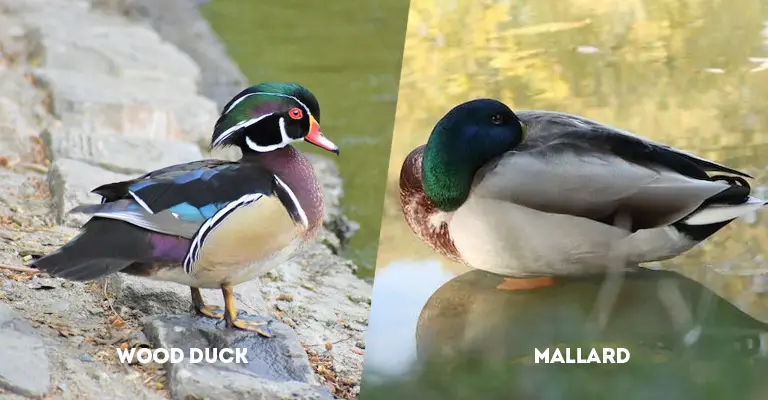
Key Differences Between Wood Duck and Mallard
Here’s a table outlining 20 key differences between wood ducks and mallards:.
Conservation Status
- Wood Duck: Wood ducks have made a remarkable comeback from a troubling past. Once facing a decline in the late 19th century due to habitat loss and hunting pressures, they are now not listed as threatened or endangered.
Conservation efforts focused on preserving wetland habitats and providing suitable nesting sites have played a pivotal role in their resurgence. - Mallard: Mallards, too, enjoy a relatively stable conservation status. They are not considered threatened or endangered. Their adaptability to diverse environments, coupled with their prolific breeding, has contributed to maintaining healthy population numbers.
Population Trend
- Wood Duck: The wood duck’s population has shown a heartening upward trend in recent decades.
Dedicated conservation initiatives, including the establishment of nest boxes and protection of wetlands, have led to increased nesting success and population growth. This rebound serves as a testament to the power of targeted conservation efforts. - Mallard: Mallards exhibit their prowess as resilient survivors, with a consistent and widespread population. Their adaptable nature has facilitated their ability to thrive in various habitats, contributing to their status as one of the most prevalent and recognizable duck species globally.
Preferred Habitat
- Wood Duck: Wood ducks favor wooded wetlands, swamps, and marshes for their habitats. Their inclination towards these environments aligns with their unique nesting behavior, as they nest in tree cavities.
This habitat preference emphasizes the importance of preserving mature forests and maintaining suitable nesting sites. - Mallard: Mallards demonstrate remarkable adaptability to different wetland habitats. From ponds to lakes, rivers to urban parks, they make their presence felt across diverse landscapes.
This adaptability is reflected in their choice of nesting sites, which can range from ground nests to nests hidden within dense vegetation.
Nesting Behavior
- Wood Duck: Wood ducks stand out due to their distinctive nesting behavior. Unlike many other duck species, wood ducks nest in tree cavities, exhibiting a behavior more akin to that of birds like woodpeckers.
This preference for nesting in tree hollows underscores the significance of mature trees within their habitats. - Mallard: Mallards follow a more conventional nesting behavior, building their nests on the ground or in vegetation.
This behavior aligns with their broader adaptability, as it allows them to take advantage of various nesting opportunities across their wide range of habitats.
Threats
- Wood Duck: Despite their recovery, wood ducks still encounter threats in the wild. Wetland loss, habitat degradation, and deforestation remain key concerns.
The destruction of mature trees with suitable nesting cavities poses a particular challenge, as it directly affects their unique nesting behavior. - Mallard: Mallards, with their adaptable nature, have a certain advantage in dealing with threats. However, like many species, they are not entirely immune.
Habitat loss due to urbanization, pollution of water bodies, and hunting pressures are potential challenges they face, particularly in areas where wetlands are being encroached upon.
Body Size
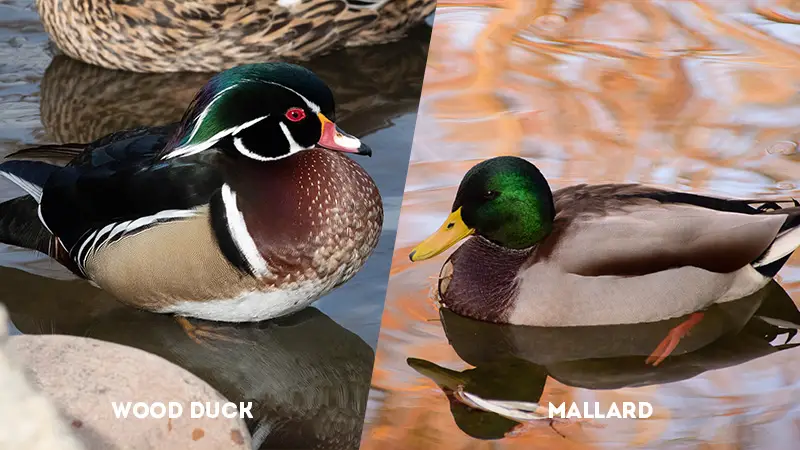
- Wood Duck: The wood duck boasts a moderately-sized physique with intricate markings that add to its charm.
Its body is characterized by a delicate blend of colorful plumage, making it an exquisite sight in wetland habitats. This mid-sized stature aligns with its preference for wooded wetlands and tree-hollow nesting. - Mallard: Mallards, in contrast, exhibit a larger and more robust body structure. Their rounder appearance and hefty build are hallmarks of this species.
The difference in size between the two species is particularly noticeable when they coexist in the same habitats, showcasing distinct adaptations to their respective environments.
Head Shape
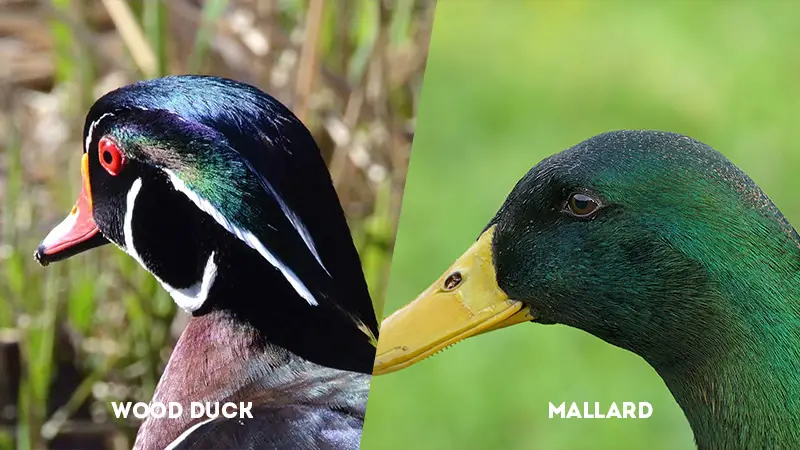
- Wood Duck: A subtle but notable distinction lies in the head shape of wood ducks. The slightly rounded head contributes to their overall elegant appearance. This feature, coupled with their strikingly colorful facial markings, adds to their appeal as one of North America’s most beautiful waterfowl.
- Mallard: Mallards are recognized for their rounded heads as well, but it’s the presence of an iridescent green or blue patch on the male mallard’s head that captures attention.
This unique head coloring, absent in wood ducks, serves as a visual cue for identifying male mallards during breeding season.
Bill Shape
- Wood Duck: The wood duck’s bill is characterized by its short length and wide, sturdy structure. This bill adaptation complements its feeding habits, allowing it to dabble at the water’s surface for insects, small aquatic plants, and other food sources.
- Mallard: Mallards possess a wide, flat bill ideally suited for their dabbling behavior. This specialized bill shape enables them to sift through the water for their preferred diet of aquatic vegetation, insects, and crustaceans. Their bill’s versatility contributes to their success in a wide range of wetland habitats.
Tail Position
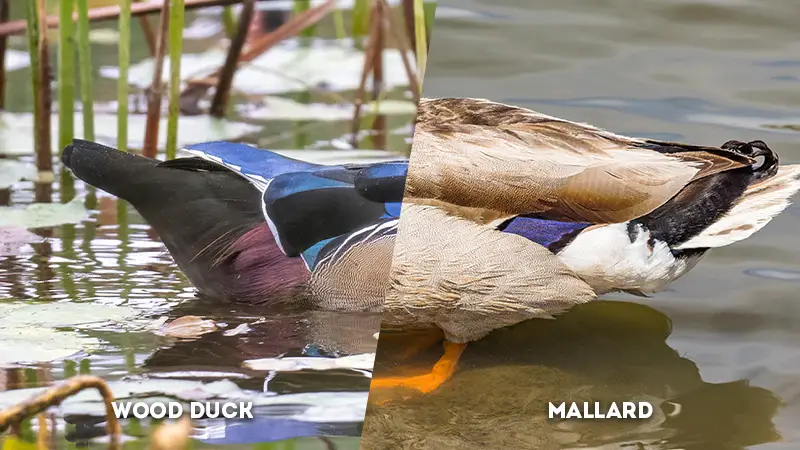
- Wood Duck: A distinctive feature of the wood duck’s posture is its relatively low tail position in the water. This tail posture contributes to its streamlined appearance while swimming, enhancing its maneuverability as it navigates through its preferred habitats of wooded wetlands and marshes.
- Mallard: Mallards present a unique silhouette with their tail riding relatively high out of the water. This characteristic trait creates a blunt shape, making them easily recognizable, especially when in flight. The high tail position serves as a visual marker for identifying mallards during observation.
Flight Characteristics
- Wood Duck: In flight, wood ducks exhibit agility and speed. Their broad wings and distinctive wing sounds contribute to their graceful movements through the air.
Despite their preference for woodlands, their flight adaptations allow them to navigate open spaces efficiently, reflecting their versatility. - Mallard: Mallards’ flight patterns are equally notable, characterized by their broad wings set toward the rear. This arrangement of wings enhances their ability to cover distances and adapt to varying flight conditions.
Their agile and strong flight serves them well during seasonal migrations and their exploration of diverse habitats.
Feeding Behavior
- Wood Duck: The wood duck’s feeding behavior is marked by its tendency to dabble on the water’s surface. This means that it primarily forages for food by tipping forward in the water, grazing on aquatic insects, small fish, and vegetation found near the water’s edge.
This behavior aligns with its preferred wooded wetland habitats, where it can easily access the shallow waters. - Mallard: Mallards are classic dabbling ducks with a feeding behavior that involves tipping forward in the water to feed on aquatic plants, insects, and small invertebrates. Their versatile diet allows them to thrive in a range of wetland environments, from urban park ponds to natural water bodies.
Mating Display
- Wood Duck: Wood ducks are known for their elaborate and captivating courtship rituals. During the mating display, the male wood duck often swims close to the female while emitting soft calls and exhibiting striking visual displays of its colorful plumage. This courtship dance serves to attract a mate and reinforce pair bonds.
- Mallard: Mallards also engage in courtship displays, although their rituals are generally less elaborate compared to those of wood ducks.
The male mallard might swim alongside the female, dip its bill in the water, and emit various calls and whistles as part of the courtship process.
Nesting Sites
- Wood Duck: Wood ducks stand out for their unique nesting behavior. They nest in tree cavities, an atypical trait among waterfowl.
This choice of nesting sites highlights their dependence on mature trees in their habitats, as well as the importance of maintaining such trees to support their reproductive success. - Mallard: Mallards are more versatile in their choice of nesting sites. They build their nests on the ground or in dense vegetation, often using natural depressions or reed beds for concealment. This adaptability allows them to exploit a wider range of nesting opportunities in various wetland habitats.
Egg Color
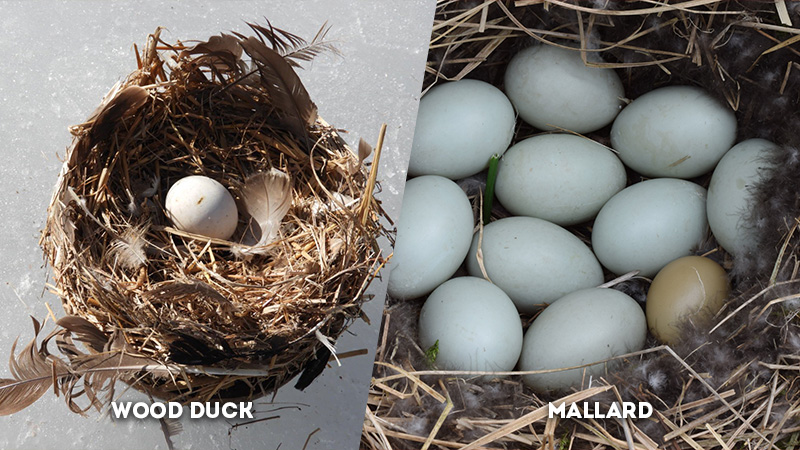
- Wood Duck: Wood duck eggs are typically pale white to creamy in color. The number of eggs in a wood duck clutch usually ranges from 9 to 14. The subdued egg coloration may help camouflage the eggs within the dark confines of their chosen nesting cavities.
- Mallard: Mallard eggs are distinguishable by their greenish-buff color, providing a visual contrast to the surroundings. A typical mallard clutch contains around 8 to 13 eggs. The distinctive egg color and shape aid in identifying mallard nests and differentiating them from other species.
Voice
- Wood Duck: Wood ducks are recognized by their high-pitched whistling calls. The vocalizations of wood ducks are often soft and melodious, adding to their mystique within the wetland habitats they inhabit.
- Mallard: Mallards are known for their varied vocalizations, including the familiar “quack” that has become synonymous with ducks. They also emit whistles, grunts, and other sounds as part of their communication repertoire.
Range
- Wood Duck: Wood ducks primarily inhabit North America, where they are commonly found in wooded wetlands, swamps, and marshes.
Their range spans across various regions of the continent, from the eastern United States to parts of western North America. Their preference for forested areas influences their distribution within their native range. - Mallard: Mallards are incredibly versatile in terms of their range. They are found not only in North America but also in Europe, Asia, and various other parts of the world.
Their adaptability to different environments has led to their widespread presence in a wide range of wetland habitats, making them one of the most geographically widespread duck species.
Migratory Behavior
- Wood Duck: While some populations of wood ducks are migratory, not all of them exhibit extensive migratory behavior.
Some wood ducks are considered year-round residents, especially in regions with suitable habitat and access to food year-round. Migratory populations of wood ducks might undertake shorter migrations in response to changing seasons. - Mallard: Mallards are known for their migratory behavior, with many populations undertaking seasonal migrations. In North America, for instance, mallards often breed in northern regions during the summer and migrate southward to more temperate areas for the winter.
Their adaptability to various habitats along migration routes contributes to their successful navigation of changing conditions.
Distinctive Features
- Wood Duck: Wood ducks are characterized by their vibrant and distinctive plumage. The males feature colorful markings, including iridescent green, purple, and white patterns on their heads, necks, and chests. This flamboyant coloration makes them stand out among other waterfowl and enhances their aesthetic appeal.
- Mallard: Mallards also possess unique features, with the most striking being the iridescent green or blue patch on the male’s head.
This head coloring, coupled with their more muted brown and tan plumage, sets them apart from other duck species. The combination of both male and female mallards’ appearances makes them easily recognizable.
Urban Adaptability
- Wood Duck: Wood ducks are less inclined to adapt to urban environments compared to mallards. Their preference for wooded wetlands and specific nesting sites limits their presence in urban and suburban areas. While they can sometimes be seen in urban settings, they are less likely to thrive in such environments.
- Mallard: Mallards are highly adaptable to urban and suburban landscapes. They are often seen in city parks, golf course ponds, and other man-made water bodies.
Their ability to make use of human-altered habitats contributes to their prevalence in both rural and urban settings.
Social Behavior
- Wood Duck: Wood ducks are typically seen in pairs or small groups, especially during the breeding season. They maintain close bonds with their mates and engage in courtship rituals that emphasize the importance of pair bonding for reproductive success.
- Mallard: Mallards display more social flexibility, often forming larger flocks, especially during migration. Their adaptable social behavior allows them to congregate in various-sized groups depending on the availability of food, water, and other resources.
Conservation Importance
- Wood Duck: Wood ducks hold conservation importance due to their historical decline and subsequent recovery efforts.
The restoration of wetland habitats, establishment of nest boxes, and protection of nesting sites have contributed to their population rebound. Continued conservation efforts are crucial to maintain and enhance their numbers and habitat quality. - Mallard: Mallards, while not currently threatened, play a significant role in wetland ecosystems as key indicators of environmental health.
Their wide distribution and adaptability make them valuable for scientific research and monitoring. By observing mallards’ responses to changing conditions, researchers gain insights into the overall well-being of wetland habitats.
Wood Duck Vs Mallard: Comparison Table
| Key Aspect | Wood Duck | Mallard |
|---|---|---|
| Conservation Status | Not listed as threatened or endangered. | Not listed as threatened or endangered. |
| Population Trend | Increased in recent decades due to conservation efforts. | Common and widespread, adaptable to various habitats. |
| Preferred Habitat | Wooded wetlands, swamps, and marshes. | Diverse wetland habitats including ponds, lakes, rivers. |
| Nesting Behavior | Nest in tree cavities, unique among ducks. | Build nests on the ground or in vegetation. |
| Threats | Faces threats like wetland loss and habitat degradation. | Adaptable nature helps in coping with changing habitats. |
| Body Size | Moderately-sized duck with distinct markings. | Robust, larger duck with distinctive features. |
| Head Shape | Slightly rounded head. | Rounded head with iridescent green or blue patch. |
| Bill Shape | Short, wide bill. | Wide, flat bill adapted for dabbling behavior. |
| Tail Position | Tail sits relatively low in the water. | Tail tends to ride high out of the water. |
| Flight Characteristics | Fast and agile flight with distinctive wing sound. | Broad wings set toward the rear in flight. |
| Feeding Behavior | Forages in water, dabbling for food on the surface. | Dabbles for food on the water’s surface. |
| Mating Display | Displays elaborate courtship behaviors. | Displays courtship rituals but less elaborate. |
| Nesting Sites | Nest in tree cavities or nest boxes. | Build nests on the ground or in dense vegetation. |
| Egg Color | Pale white to creamy, about 9-14 eggs per clutch. | Greenish-buff eggs, about 8-13 eggs per clutch. |
| Voice | High-pitched whistling calls. | Quacks, whistles, and various vocalizations. |
| Range | North America, prefers wooded habitats. | Worldwide distribution, adaptable to many climates. |
| Migratory Behavior | Some populations are migratory. | Populations can be migratory or sedentary. |
| Distinctive Features | Colorful plumage, distinctive facial markings. | Iridescent green head (male), distinct markings. |
| Urban Adaptability | Less likely to adapt to urban environments. | Often found in urban parks and ponds. |
| Social Behavior | Often seen in pairs or small groups. | Can form large flocks, especially during migration. |
| Conservation Importance | Benefitted from conservation efforts, still needs protection. | Thrives in various habitats, not currently threatened. |
Frequently Asked Questions
Yes, wood ducks and mallards can hybridize in some cases, particularly when their habitats overlap. While hybridization is relatively rare due to differences in nesting behavior and habitat preferences, instances of crossbreeding have been documented.
Wood ducks have evolved certain behaviors to minimize predation. One notable behavior is “branching,” where ducklings leap from their nesting cavities to the ground soon after hatching. This helps them avoid being easy prey for ground-based predators.
Both wood ducks and mallards contribute to wetland ecosystem health. Their feeding behaviors help control insect populations, and their interactions with aquatic plants aid in maintaining balanced ecosystems. Mallards, with their widespread presence, can serve as indicators of wetland quality.
While mallards are known for their extensive migratory behavior and often follow established migration routes, wood ducks’ migratory patterns are less defined. Wood ducks exhibit variable migration behaviors depending on their geographic location and available resources.
Both wood ducks and mallards communicate using a range of vocalizations. Wood ducks emit soft whistling calls, while mallards are known for their quacks, whistles, and grunts. These vocalizations are used for various purposes, including mating displays, territorial claims, and communication within flocks.
To Recap
In the tapestry of biodiversity, the differences between wood ducks and mallards reflect the remarkable diversity of life’s adaptations.
From their distinct nesting behaviors to migratory patterns, each facet contributes to their unique roles within ecosystems. As we appreciate their nuances, we reinforce the urgency of conservation efforts.
Preserving wetlands, protecting habitats, and understanding these avian wonders ensure that future generations can continue to marvel at the elegance of wood ducks and mallards, reminding us of the intricate connections that sustain the delicate balance of our planet’s natural wonders.